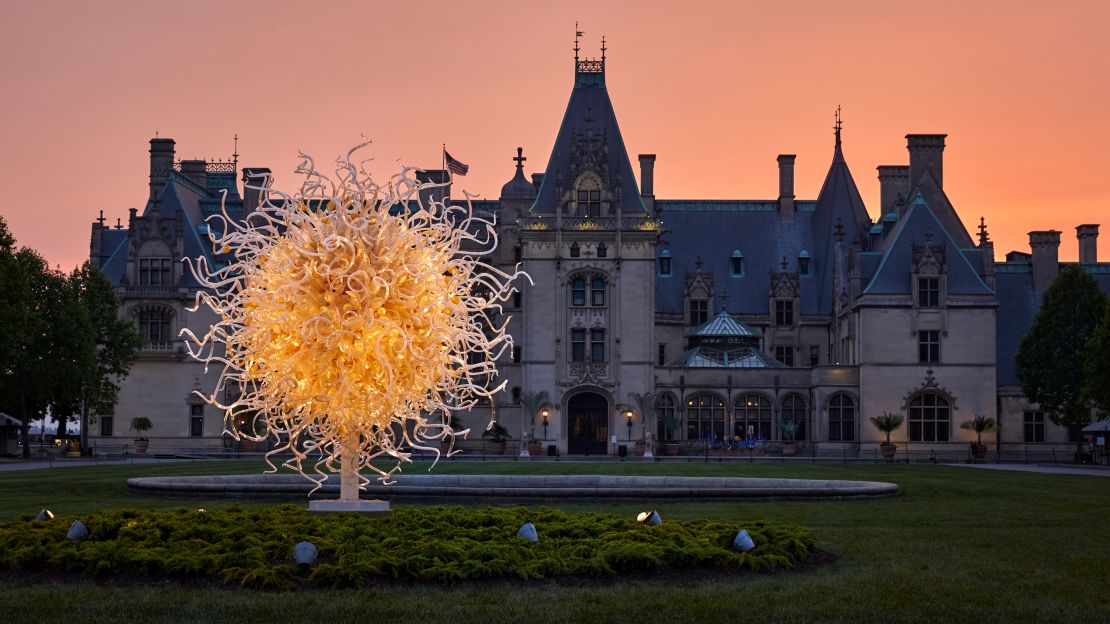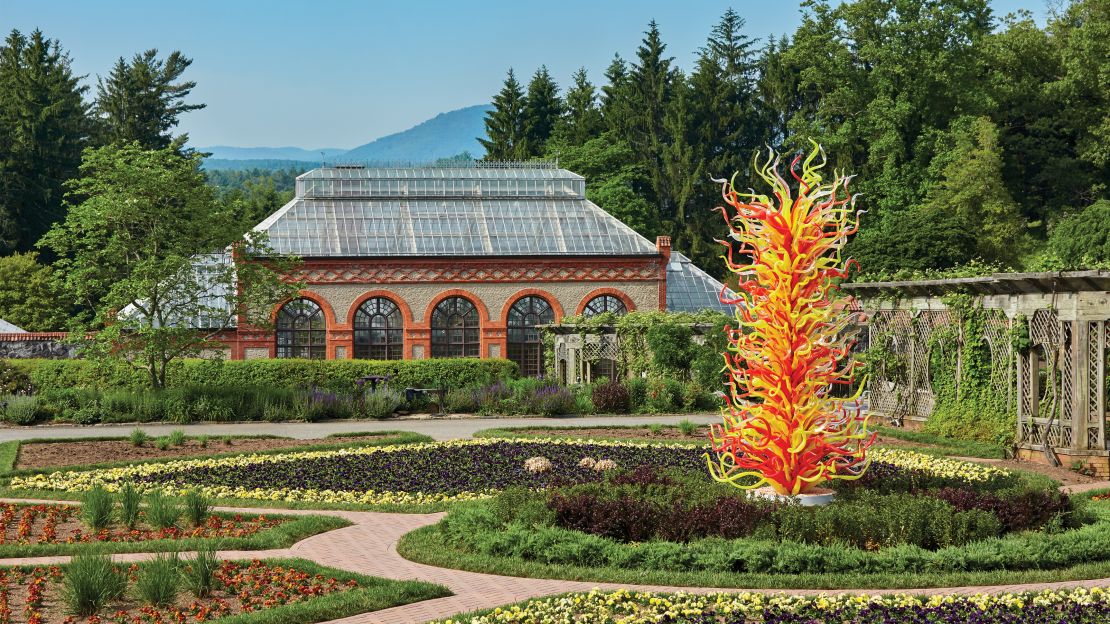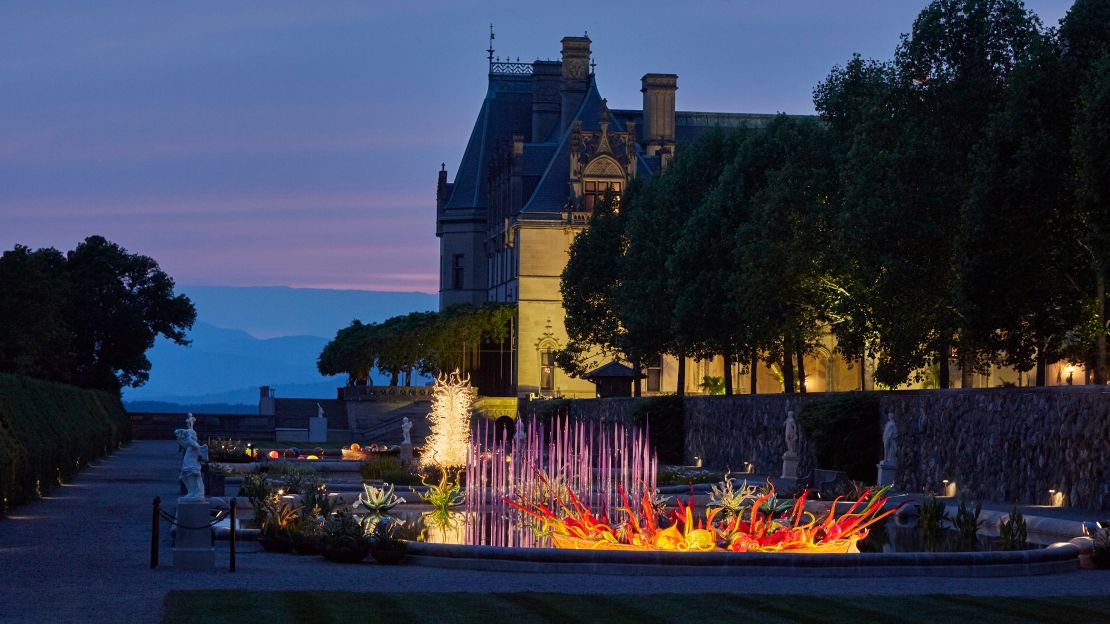Standing on tall ladders, two workers place pieces of brightly colored glass onto a tree-like structure in the middle of a manicured garden at Biltmore.
As visitors to the Asheville, North Carolina, estate gather to watch their progress, renowned glass artist Dale Chihuly’s team takes the better part of a day to install “Electric Yellow and Deep Coral Tower” and “Paintbrush Tower” in the estate’s Walled Garden.
“Are all the pieces numbered?” asks one person after another, looking up at installation head Rick Holland and other Chihuly installers during the two-week installation process in May.
No, amazingly, they are not.
“Chihuly at Biltmore” is Chihuly’s first major exhibition in North Carolina of his 50-year career. It’s also the first time that the descendants of George Vanderbilt, who still own the 250-room home and estate through The Biltmore Company, have hosted an outdoor art exhibition in the gardens.
It’s also time for another first: Biltmore, the largest private home in the United States, has never hosted an evening experience in the gardens before.
His descendants and the staff of the company that is now Biltmore think Vanderbilt would have approved.
That’s because George and wife Edith Vanderbilt championed artists on the estate – the walls feature the work of John Singer Sargent and Pierre-Auguste Renoir, among others.
And the gardens themselves are a work of art, designed by New York Central Park landscape architect Frederick Law Olmsted and featuring a statue of Diana and 34 other outdoor sculptures on the grounds.

The estate, which was the creation of George Vanderbilt, architect Richard Morris Hunt and Olmsted, was opened to Vanderbilt’s family and friends just before Christmas in 1895. (Vanderbilt died in 1914, at age 51.)
“When George Vanderbilt was putting this landscape together,” says Biltmore horticulture director Parker Andes, “he wanted a garden and grounds that his guests would enjoy.”
“A garden of ornament,” Andes says, quoting George Vanderbilt.
With the Chihuly exhibition, “we’re doing the same thing today that George Vanderbilt wanted for his guests in the 1890s,” says Andres.
Biltmore has more than 100,000 annual passholders who explore the 8,000-acre estate, and those who were exploring the grounds during the two-week installation process in May are curious.
An artist from the working classes
Chihuly first shook up the art world in the 1970s, the son of a butcher/union organizer who died suddenly at age 51 (the same age as George Vanderbilt). His mother was an avid gardener, which influenced his later work, and she pushed him to go to college.
Chihuly discovered glass blowing while taking a weaving class and interior design courses in college. Weaving glass panes through woven textiles one day, he picked up a pane of melted glass with a pipe and blew a little bubble, says Britt Cornett, Chihuly’s director of exhibitions.
“From that moment, he was hooked,” she says. “He set about finding out everything he could about glass blowing.”
Since the early 1970s, the Tacoma, Washington-born artist has made the Pacific Northwest a center of glass art.
He helped launch the Pilchuck Glass School near Seattle in 1971, and the Museum of Glass in Tacoma in 2002 and welcomed artists flocking to the area. The 1.5-acre Chihuly Garden and Glass stood at the foot of Seattle Space Needle since 2012.
He made a big splash in 1996 with his “Chihuly Over Venice” project, in which many of which works were placed in and around the Italian city’s canals. Now his work can be found in the permanent collections and temporary exhibitions of museums and gardens around the world.
Gardens filled with glass

His work is now instantly identifiable as a “Chihuly” anywhere, with his different colored blown glass evoking fauna and flora from nature and the sea. His shows, mostly installed in gardens and other outdoor spaces – inspired by his mother’s gardening – are wildly popular and attract lots of visitors who don’t normally visit the gardens.
Now 76 and suffering from bipolar disorder and the effects of a 1976 car crash that took the vision in one eye, Chihuly can’t do the physical labor that glass art often demands in its creation. That he hands over to his team he’s collected around him since his early days.
With recent shows in the Atlanta Botanical Garden, the New York Botanical Garden and now Biltmore, he creates new and modifies old designs for shows and has others do the hard labor.
While he has detractors who criticize his approach and his popularity outside the art world, Chihuly has mostly championed a team approach similar to a Renaissance studio with the masters of that era.
There’s no doubt he’s slowed down in his 70s. Biltmore CEO Bill Cecil, Jr. (Vanderbilt’s great-grandson) and Chihuly’s wife, Leslie – who is president of the studio – did most of the talking at the mid-May media preview.
Asked by Leslie Chihuly if he wanted to say anything about the exhibition, Dale Chihuly said, “I’m very excited about the show, and I want to thank Biltmore for making it happen.”
Working without speaking
So many of Chihuly’s team have been working for him on those shows for more than a decade and know his process and well.
That’s why they don’t need any of the individual pieces numbered for the 16 installations in “Chihuly at Biltmore,” which runs through October 7, although the boxes are labeled.
Two installers in waders slowly fill a boat in one of the Italian Garden ponds with floats, round glass objects of varying sizes, weighing anywhere from 10 to 50 pounds.
A nod and a look is enough communication to agree they need to add a couple more floats before it’s done.
With Biltmore staff monitoring storms miles in the distance, the installers finish filling the “Float Boat” without ever speaking out loud to each other – and later add more floats seemingly spilling into the water around it.
It starts in the Seattle studio
Whether the Chihuly installations are entirely new works, new configurations made from existing pieces or pieces that have been shown before, Cornett says Chihuly develops the concept first on paper.
After any new pieces are made in his hot shop, the crew gathers in Chihuly’s cavernous Seattle studio to build the installations and get the artist’s final approval. The same crew will install the pieces on location.
Then the installations are disassembled, organized into sections and packed for transport. Hundreds of cardboard boxes marked “fragile” and “glass” fill several privately contracted container trucks for this show’s trip across the country.
Boxes are unloaded at the 16 sites around the garden as the two-week installation process proceeds, and visitors watch as workers unpack thousands of pieces and lay them on moving blankets for their colleagues to install.

Asked many questions wherever they are installing Chihuly’s work, Holland, Gerber and others know their work is part performance art. Annual passholders promise to come back, bringing guests.
Although they answer questions from guests, the installers rarely speak to each other, seemingly communicating with a nod or raised eyebrow to decide if they’re placed the pieces in the right places.
(Yes, occasionally a piece will break. There are a few spares sent along to each installation.)
The pieces have mostly been installed at the carefully designed gardens on the estate, with just one installation inside the house’s Winter Garden and two placed at nearby Antler Village and Winery, where guests at the estate’s two hotels and passholders often eat and enjoy a glass of wine produced on the estate.
The seasons change the exhibition
While Biltmore and Chihuly staffers have been talking about a show for more than a decade, the project finally came together in 2015, with the Chihuly team making its first site visit late that year. Andes and the estate gardeners worked closely with Chihuly “for a full year, discussing planting plans and locations for the installations,” Andes says.
Summer will give way to fall, and plant life will change the look of the work, he says.
So will viewing Chihuly at night.
Chihuly lighting designer Steven Cochran has been working through the night for weeks – often alone – to create the “Chihuly at Night” show. (It requires a separate ticket.)
At night, the “Sol d’Oro” in front of the house becomes a shining globe shining in the night. The floats in the “Float Boat” become glowing balls of color. The “Pergola Garden Fiori” integrates Chihuly with Biltmore’s own busts (which are believed to be allegories of the four seasons). And three Chihuly chandeliers shine on the conservatory at night.
That’s the job of Steven Cochran, Chihuly’s lighting designer, who has to design a site-specific lighting system that withstands weather, changing plant and animal life, while making Chihuly’s work look like it’s lit from within.
Working throughout the day and night to install and test the lighting, he’s often alone in the dark when the lights come on.
“One of the joys of my job is that I get to be the first person to see this at night,” he says. When the lighting for a piece comes together, “it’s usually late at night and I’m usually by myself. I know what people are going to be talking about.”
A lighting expert’s favorite time of day
Cochran recommends arriving just before twilight to enjoy the day’s journey into night at the gardens.
“I enjoy watching the changing of the light is twilight to sunset and to see the gradient of color in the sky as the artwork begins to light with the artificial lighting and takes over from the daylight as the daylight fades and the sky changes from blue to dusk, to dark, that’s a really beautiful time,” he says.
“Of course, when you’re out in the gardens, in an environment like here at Biltmore, it’s magical.”

If you go: “Chihuly at Biltmore” is open through October 7, 2018. Biltmore Estate, 1 Lodge St, Asheville, NC 28803. Daytime admission to the estate ranges from $57-$75, including a $10 discount for advance purchase and includes a self-guided tour of the house and daytime viewing of the Chihuly exhibition. Pricing for “Chihuly Nights at Biltmore” also varies from $57-$75, including a $10 discount for advance purchase. A nighttime ticket includes a self-guided tour of the first floor of Biltmore House. The two hotels on the estate offer a variety of packages that include admission to the exhibition.

















